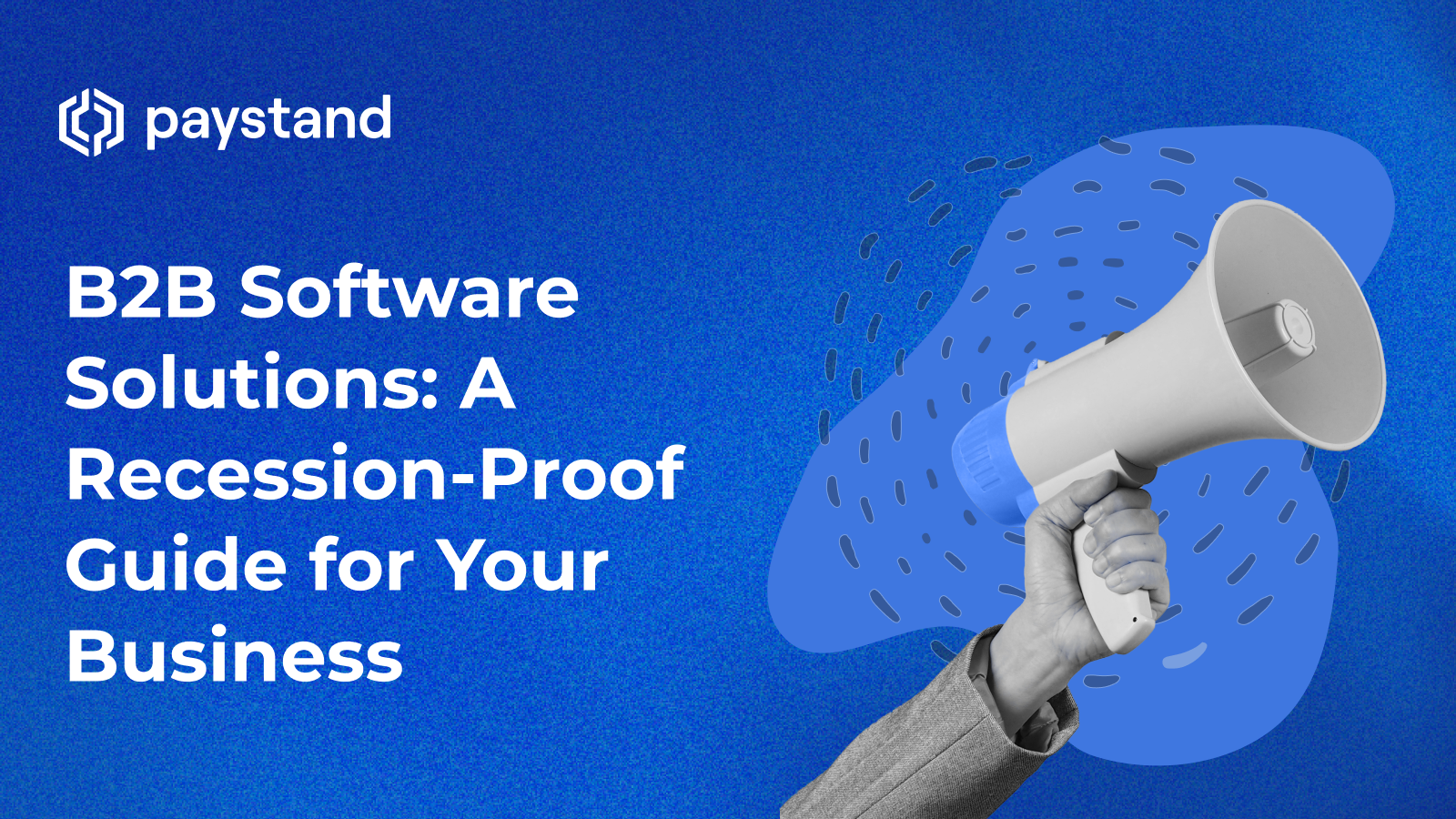B2B Software Solutions: A Recession-Proof Guide for Your Business

Table of Contents
- What is a B2B Software System?
- What Are B2B Solutions?
- What is a B2B SaaS Example?
- What is SaaS vs. B2B Software?
- How B2B Software Solutions Address Economic Challenges
- Top B2B Software Categories
- Recession-Proof Your Revenue with AR Automation
Key Takeaways
- Discover what B2B software systems are and how they empower businesses to navigate challenges like recessions.
- Learn the difference between B2B SaaS and traditional software and explore examples of successful solutions.
- Understand how cloud-based tools streamline operations, cut costs, and drive agility.
- Explore top software categories like CRM, accounting, and digital signature solutions.
- Find out how Paystand's AR automation can recession-proof your revenue and scale your business.
With an ebbing and flowing economic landscape marked by uncertainties like inflation, market fluctuations, and rising operational costs, businesses are under immense pressure to stay competitive. Navigating a potential recession or other financial instabilities demands innovative solutions, which is where B2B software solutions step in.
Cloud-based systems, in particular, have emerged as game-changers for businesses aiming to adapt quickly, cut costs, and innovate without disruption. Whether it’s streamlining workflows, improving customer interactions, or automating repetitive tasks, these tools ensure that businesses can thrive, even in turbulent times.
This guide explores the essential B2B software solutions every business needs to weather economic challenges while staying agile and efficient.
What is a B2B Software System?
A B2B software system refers to applications designed to help businesses manage processes, enhance productivity, and optimize operations. These systems often include tools for customer relationship management (CRM), accounting, marketing, and supply chain management, tailored for business-to-business operations.
What Are B2B Solutions?
B2B solutions encompass software and services that solve specific challenges faced by businesses. From streamlining workflows to automating repetitive tasks, these solutions aim to improve efficiency and deliver measurable results. Examples include cloud-based CRMs like Salesforce and financial platforms like Paystand.
What is a B2B SaaS Example?
B2B SaaS (Software as a Service) refers to subscription-based software hosted in the cloud. Examples include:
- HubSpot for marketing and sales alignment.
- QuickBooks Online for accounting.
- DocuSign for digital signatures.
These tools allow businesses to access and manage data from anywhere, making them ideal for remote or hybrid work environments.
What is SaaS vs. B2B Software?
SaaS is a delivery model for software where users access applications via the internet, often through a subscription. B2B software can be SaaS-based or on-premises, depending on the needs of the business. SaaS offers scalability, lower upfront costs, and easy updates, while traditional B2B software may require more maintenance and infrastructure.
How B2B Software Solutions Address Economic Challenges
In today’s unpredictable economic landscape, marked by rising inflation, fluctuating markets, and global uncertainties, businesses need to stay agile. B2B software solutions, particularly cloud-based systems, provide the flexibility and cost-efficiency needed to navigate these challenges.
- Cost Savings: Cloud-based tools eliminate the need for expensive hardware and maintenance.
- Agility: Quickly scale operations up or down as market conditions change.
- Innovation: Automate manual tasks and free up resources to focus on strategic growth.
During recessions, companies leveraging B2B software solutions are better equipped to adapt to economic pressures and maintain stability.
Top B2B Software Categories
Office and Email Software
- Microsoft Office 365: A cloud-based remake of OfficeSuite, starting at $4/user/month. It integrates email, Word, Excel, and more, allowing seamless collaboration.
- Google Workspace: Starting at $6/user/month, it includes Gmail, Google Docs, and Sheets, offering a modern alternative to Microsoft’s suite.
Accounting and Invoicing Software
- QuickBooks Online: Affordable and simple to use, ideal for small businesses. It includes inventory, payroll, and bill payment.
- NetSuite and Sage Intacct: Cloud-based ERPs offering advanced financial tools, seamless integrations, and scalability to meet enterprise needs.
Contract and Digital Signature Tools
- DocuSign: Simplifies document signing and storage, making approval processes faster and more efficient.
CRM Software
- Salesforce: A leading cloud CRM that tracks sales activities and automates customer interactions.
- HubSpot: Combines CRM, marketing, and hosting solutions for seamless integration across business functions.
Recession-Proof Your Revenue with AR Automation
Paystand provides a self-driving AR solution that helps businesses achieve fast, efficient, and profitable payments. By automating accounts receivable, companies can scale operations without increasing manual tasks or fees.
Ready to recession-proof your business? Learn how to automate collections with Paystand and the importance of digitizing your payments.





%20(1)%20(1).jpg?width=100&height=100&name=IMG_3752%20(1)%20(1)%20(1).jpg)